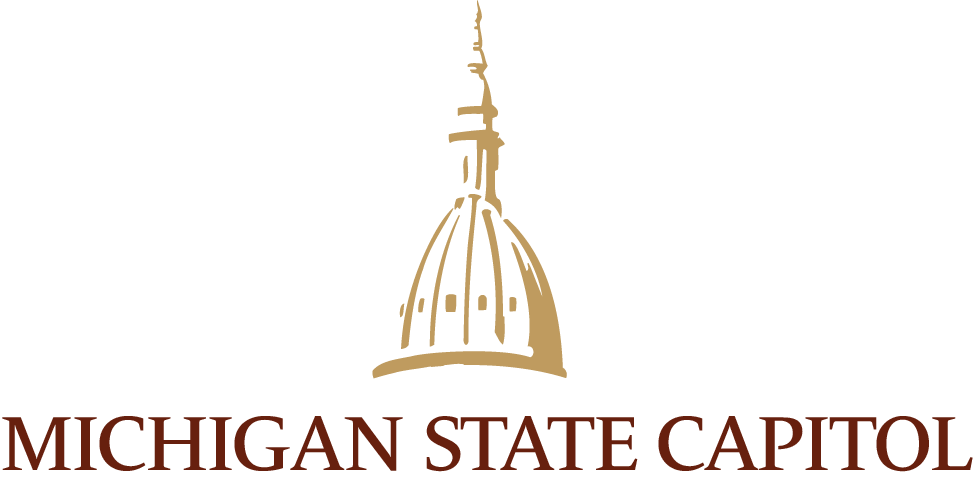
Capitol Preservation Projects
Over the last 150 year, the Michigan State Capitol has endured many major projects. While all were, arguably, done with some measure of good intentions, not all benefitted the building long term. Not surprisingly, the broad arc of the building’s history is tied very closely to national trends in architecture, modernization, demolition, and the rise of historic preservation.









Construction (1872-1878)
Photos courtesy the Jenison Collection in the Archives of Michigan
The current Michigan State Capitol – our state’s third – was constructed from 1872 to 1878. Designed by Elijah E. Myers, the building was intended to house all three branches of government under one roof. It is comprised of roughly 19 million bricks and faced in Berea sandstone quarried in northeast Ohio. Our Capitol’s dome (made of iron wrought and cast by the S.J. Creswell Company of Philadelphia and ornamented with tin sheet metal from John Siddons of Rochester) is an architectural nod to, and slender reinterpretation of, the United States Capitol dome which was completed in the 1860s.
Learn more about the Capitol’s construction in The Watch of the Capitol.








Decoration (1885-1890)
Historic images courtesy of the Craig Whitford Collection & the Rambo Family Collection. Modern photos by David Marvin.
In 1885, the Michigan Legislature began funding the decoration of the Capitol’s plaster walls and ceilings. Over a nearly six-year period, the William Wright Company of Detroit transformed the Capitol’s white surfaces with stenciling, marbling, woodgraining, and freehand art in a rainbow of motifs and colors. By the time the project ended, Michigan’s Capitol featured over nine acres (or football fields) of hand-painted decoration.
Learn more about the William Wright Company’s work in our Capitol.







Electrification (c. 1885-1905)
Michigan’s third Capitol was originally outfitted with gas lighting – the best technology of the 1870s. But by the end of the decade, electric lights were available. Within a few years, Capitol caretakers began the slow process of retrofitting hundreds of gas fixtures for electricity. By the time the project officially ended in 1905, thousands of lightbulbs burned daily in the Capitol, while another 800 lit the exterior dome!





Legislative Chamber Modifications (1930s-1970s)
Throughout the twentieth century, the House and Senate undertook a series of “upgrades” intended to keep their Chamber up-to-date. Some projects, like the 1936 installation of electric voting boards in the House, streamlined the voting process and heralded further mechanization. Others, such as the removal of original lighting fixtures and the original etched skylight tiles, were an attempt to update the Capitol’s old fashioned, out-of-date Victorian look. With each project, more of the building’s historical integrity was lost.








A New, Atomic Age Capitol? (1966-1973)
By the mid-twentieth century, a growing number of state officials were asking if Michigan’s current Capitol could still meet the needs of a modern state. In the 1960s, the state commissioned numerous architectural renderings for a sleek, Modern-style fourth Capitol. Exhibited on the glass floor, the fourth Capitol drawings were widely panned by members of the press and the general public, who still loved our increasingly beleaguered old Capitol. Declining budgets, the sudden departure of a high-ranking official, and lack of public support meant that these plans were eventually shelved and, in time, abandoned.






A Maze of Overfloors (1970-1979)
Both Michigan’s population, and the functions of state government, grew dramatically in the twentieth century. Not surprisingly, it quickly rendered Michigan’s Capitol – built for a state with one tenth the population – too small. One popular make-do solution to address the perpetual lack of space was to cut the roughly twenty-foot-tall offices in half with horizontal subdivisions. Commonly called half-floors or overfloors, these new additions turned the Capitol into a maze of tiny, hard-to-access workspaces. Yet despite the challenges posed by the overfloors, they prolonged the life of the building through the mid to late twentieth century.








An Award-Winning Restoration (1987-1992)
In his 1982 State of the State address to the Legislature, Governor William Milliken proposed forming a group to study the possibility of preserving and restoring the Michigan State Capitol. Soon after the non-profit Friends of the Capitol formed and began commissioning architectural studies for the restoration of the once-grand, but now badly-modified building.
In 1987, the Michigan State Capitol Committee, a body comprised of legislative and executive members, turned those plans into reality by funding and supporting a series of projects that evolved into a five-year, $58 million restoration. The project – which reversed decades of ill-conceived modifications, updated the Capitol’s systems and technology, and returned to the building to its original aesthetic – won national awards for architecture, engineering, and historic preservation. At its conclusion in 1992, the Michigan State Capitol was named a National Historic Landmark – the highest honor accorded American buildings.






Exterior Renewal & Infrastructure Upgrade (2015-2020)
The work of historic preservation is never done. After forming in 2014, the Michigan State Capitol Commission undertook a major renewal of the Capitol’s exterior stonework and dome before starting to upgrade the Capitol’s outdated heating and cooling, electrical, plumbing, and fire safety systems. This led to the installation of a geothermal field containing 272, 500-foot well on the west side of Capitol Square. As of 2022, the Capitol’s heating and cooling is powered by this green, ecofriendly system expected to last upwards of 50 years.










Heritage Hall (2019-2022)
The installation of the geothermal field reignited as old discussions about the feasibility of building an underground addition on the west side of Capitol Square. In 2018, the Michigan State Capitol Commission officially greenlit the construction of Heritage Hall, a 40,000 square foot, $40 million visitor and events center. Constructed from 2019-2022, Heritage Hall provides much-needed space for educational tours, exhibits, events, and meetings. Its long-term use ensures the better preservation of the historic Capitol building by relieving its worst daily pressures.
Learn more about the history, construction, and design of Heritage Hall!
Photography by Dave Thompson

